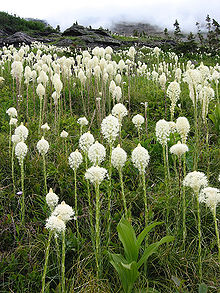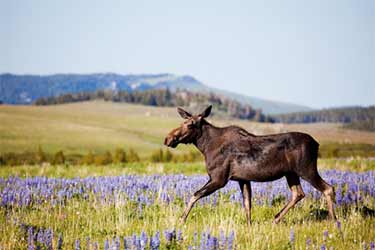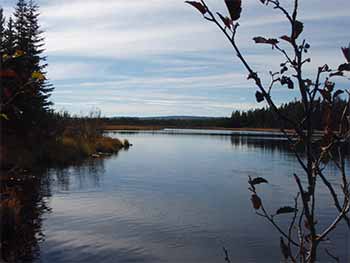
The Hunting Definition - The Moose Hunters Glossary
The hunting definition or moose hunter's glossary is here to clear up some of the terminology that novice hunters may not understand. Written with the novice hunter in mind, experienced hunters may also benefit from some of the terms and definitions.
A lot of writers, including myself, often forget that the reader of any given article may not understand the terminology used in the editorial.
Therefore I will attempt to add some clarification to some of the terms used by outdoor writers.
To the Novice:
Outdoorsmen/women are looking for information on how best to locate wild animals. I write my articles to help you succeed in your goals. Unfortunately there are often times when a writer, with good intentions will write an article that to the inexperienced will just-not-make-sense!

Beargrass
Photo courtesy of the National Parks Service
To the Professional or Experienced:
Have you ever read an article
and come across a term or theme based article that just doesn't gel?
There are many studies written by biologists, scientists and PhDs that
are meant for scholars. Do you or have you ever read one of those
papers? Sometimes the language used, takes what could be a very
interesting article and turns it into gibberish.
Unfortunately
scholarly papers are, for most part not meant for us laymen to read or
understand. The accompanying tables, charts and figures often leave us
more perplexed than if we had never read the article in the first place.
My wish is for The Hunting Definition - Moose Hunters Glossary, to shed
some light on these eye-blurring-doctorial papers and to define some
common terminology used by writers.
This page I am sure will have
its shortcomings, so I will ask for your forgiveness in advance. If you
know of a term or definition that I haven't listed or have more
information about; please contact us and we'll be more than happy to
consider your contribution.
HUNTING DEFINITION
THE MOOSE HUNTERS GLOSSARY
Hunting Definition - Moose Hunting History
The
process of hunting and gathering has been with mankind for millennia.
The act of hunting may include the use of modern day weapons or those of
centuries past, the primitive.
Most authorities believe that man
arrived in North America via the Beringian Connection which was a land
connection (as the ice fields receded) between the old world and the new
world. It is believed that man and moose arrived at about the same time
period, somewhere between 10,000 and 70,000 years ago.
In the north
where food was scarce it was often feast or famine. Because caribou
were of the migratory type; as a food source, were not always available.
The
moose however were available as a food source year round. The early
natives' hunted moose, using primitive weapons, such as knives, spears
and clubs.
Natives across the moose range have said the moose is the
most difficult animal to kill while the buffalo is the easiest. Teddy
Roosevelt said he thought hunting moose was par with hunting whitetailed
deer, being they were somewhat more wary than elk or mule deer.
Hunting Definition - Moose Habitation
As
moose populated North America they spread across the entire tundra, the
boreal forest, the pacific coast and the northern intermountain and
eventually the southeast. Moose are not tolerable of extreme
temperatures and at least initially inhabited areas of temperature
ranges of -20° C (-5° F) to 15.5° C (60° F). Moose in winter coats are
stressed at temperatures above 5.1° C (23° F), moose in summer coats
suffer stress at temperatures above 14° C (59° F). It is unknown exactly
what the lower threshold temperature is for moose. They have been
observed at temperatures below -40° C (-40° F) and thriving.

Hunting Definition - Ease of Hunting Moose
The easiest time of
year to hunt moose is during the rut. The rut (moose mating season)
typically is 15th of September through the 30th of October (rough
dates). The peak of the rut is usually the first two weeks of October.
Of course these dates can vary from region to region.
Moose are easiest to hunt at this time of year for a few reasons.
1)
They are vocal at this time of year. Both sexes become vocal. Cows
will moan (Ahhhh, with a quivering pitch) and bulls will grunt (Orgh) in
response.
2) Because both sexes are looking for mates they tend to be less cautious in their travels through the forest.
Hunting Definition - Moose Hunting Techniques
First
nation's tribes used various methods of hunting moose before the
introduction of the firearm. These methods included but were not limited
to: chasing moose by canoe while they swam (bulldogging), spring moose
hunting in deep crusted snow, snaring and driving moose into narrows or
traps.
Hunting Definition - Modern Day Hunting
Governed
by authorities has typically regulated moose hunting to the fall
seasons. Today's moose hunting techniques are limited to firearms
(smokeless and black powder) and archery tackle. Archers equipment
consists of the long bow, compound bow and much to the chagrin of some
archers (the purists)... crossbow archers.
Hunting Definition - Techniques of the Modern-day Moose Hunter
One
of the most satisfying ways to hunt moose is to call them. Calling
moose originated in the Northeast and was documented as early as 1855.
Calling moose during windy periods is not considered an effective moose
hunting technique as the moose are more wary during times of windy
conditions.
To call moose within a few yards is an exciting
experience. The hunters or photographers can be close enough as to
actually hear the great animals breathing.
Hunting Definition - Stalking or "Still Hunting"
Not so
still actually. The act (or art) of still-hunting actually involves
movement. The hunter or photographer moves slowly, stealthfully towards
the intended target. The technique of still hunting involves for the
most part – taking a few steps then watching and listening, scanning the
area 360 degrees looking for sign. Possibly an ear or patch of fur that
will be visible though a small opening, may be the only clue an animal
is close at hand.
This
method of tracking moose or deer can be quite rewarding too! The
watchful eye may notice freshly browsed willows on which some saliva
still clings. Imagine your excitement at finding a partially chewed
leaf, dropped while the feeding animal reached for a new mouthful of
leaves or grass. You would know your quarry is close at hand.
When
approaching an animal that is, or was feeding you may find them bedded
down. Wistfully ruminating, resting before the next feeding period.
Always try to approach an animal from the downwind side, if they smell
you or hear your approach they will surely escape before you discover
them.
Moose have a habit of circling downwind just before they bed
down, this way they back-track and will discover predators that may be
following.
Generally, stalking or still hunting is considered to be the most difficult to be successful at. This is because a moose (or deer) at rest is completely aware of his surroundings and will detect seemingly imperceptible sounds and movements. Moose will bed in the thickest areas of the forest to avoid detection, the stalking hunter must use his absolute best moose hunting techniques to outwit a moose at rest.

Moose Butter
Food made from boiled and pulverized moose bones and moose marrow.
Moose Call
The traditional call made from rolled birch-bark. Also known as a Moose Horn.
Moose Estrus or Heat
The period of time in which a cow moose will allow a bull to mount. The estrus can last for as little as 1 hour to as long as 36 hours, the average being from 15 – 26 hours.
Moose Eyes and Vision
It is generally understood that moose have poor eyesight; although little is known of the acuteness of their vision. However; it is known that moose must move their heads in order to see objects at close range. Unlike humans moose have the ability to move their eyes independently. Moose rely more upon their keen sense of smell and hearing than that of vision.
Hunting Definition - Moose Feeding Periods
Moose will feed during a moonlit night or from an hour or so before sunrise to about an hour after sunrise before going into the forest to bed down and ruminate. Again in the evening moose will become active and browse until well after dark. Moose are most easily called and enticed in the morning, especially if the pursuer begins calling an hour or more before sunrise. Getting their interest and having a moose expose himself is much easier before they bed down. Once bedded, they will listen with great interest to your calling; later once the moose begins his feeding pattern he may investigate the luring sounds which you were wistfully sending out into the woods. Too bad for you if you are not still there!
Sometimes moose will not investigate right away; it may take several days before he gets to the area from where you were calling. Most experienced moose hunters will target a specific area for several days in a row before moving to a new location.
More from Hunting Definitions:
Moose Grass
Bear Grass - Xerophyllum tenax. Bear grass looks like grass but is really part of the lily family.
Moose Hearing
Moose have large ears and extremely sensitive hearing.
Moose Horn
Same as moose call
Moose Hunting Supplies
Sufficient hunting gear to equip the moose hunter to facilitate in the location of moose, be comfortable and safe while hunting.
Mooseling
Calfmoose
Moose Nose
The moose nose
has sensitivity far superior to that of humans. Moose have huge nasal
cavities which are lined with millions of moist smell-sensing cells.
When a molecule of odor is sensed by one of these sensitive cells a
signal is sent to the brain, and a response is triggered.
Related to the moose nose is the Jacobson's Organ
The
Jacobson's organ is found in the roof of the mouth. It is believed the
Jacobson's organ is used to detect primarily sexual smells or odors. In
order for a moose to use his Jacobson's organ he must tilt his head up,
his upper lip back and open his mouth. This process of odor detection is
called "flehmen".
Hunting Definition - Moose Population Density
Although
moose are large animals they are very difficult to count unless the
inventories are competed during ideal conditions. The poor results or
non-existence of these studies of some jurisdictions limits wildlife
managers in their abilities to manage and estimate moose populations. In
many areas of North America the study methods vary leaving it difficult
to compare results from one area to another. However; often enough data
is collected to achieve a confidence level of moose population
densities.
Moose Hunting Rifle
A firearm with capable of discharging a bullet with sufficient energy to dispatch a moose humanely and efficiently.

Moose and its Spiritualism
In past millennia first nation's tribe had certain firm beliefs regarding moose.
One
belief of significant proportions was that moose would give themselves
up to hunters who showed respect and dignity to the survival of the
species. Hunters, it was believed, could search for and attempt to
locate and kill a moose; he would be unsuccessful until the moose
allowed himself to be found. The moose, only revealing himself to those
hunters who were competent, solicitous and reverent. The spirituality of
the hunter was affirmed on each hunt.
Moose Tick
Wood or winter tick
Moosey
Suggestive that an area should be good habitat for moose
Hunting Definition - Moose Wallow
Bull
moose will begin to create scent pits as early as the beginning of
September, although the breeding season does not usually begin until the
middle of the month. Areas of soft ground which a bull moose will
scrape with his hoof and then urinate and salivate in; this is done to
attract the female cow moose. This muddy area will have a distinct
aroma; the male will wallow in it to perfume himself. The bull moose
will check his wallow several times from creation until after the
breeding cycle to see if any interested cow moose are waiting.
Moose Wintering Grounds
An
area where there is a sufficient food source, shelter from: severe
weather, deep snow and extremely cold or overly warm temperatures.
Want to learn how to hunt moose? Or are you wanting to increase your moose hunting skills?
Look no further!
Our moose hunting tips book is written with
not just the novice in mind, there are tips in the book that even the
most seasoned moose hunter will find of value.
The book includes 57 chapters, with more than 150 pages of information, jam packed with tips, techniques and discussions - The Ultimate Guide to Moose Hunting!
And don't forget to order one of our Fiberglass Moose Calls. In stock and ready to ship.
Top of the Hunting Definition Page







Comments
Have your say about what you just read! Leave me a comment in the box below.